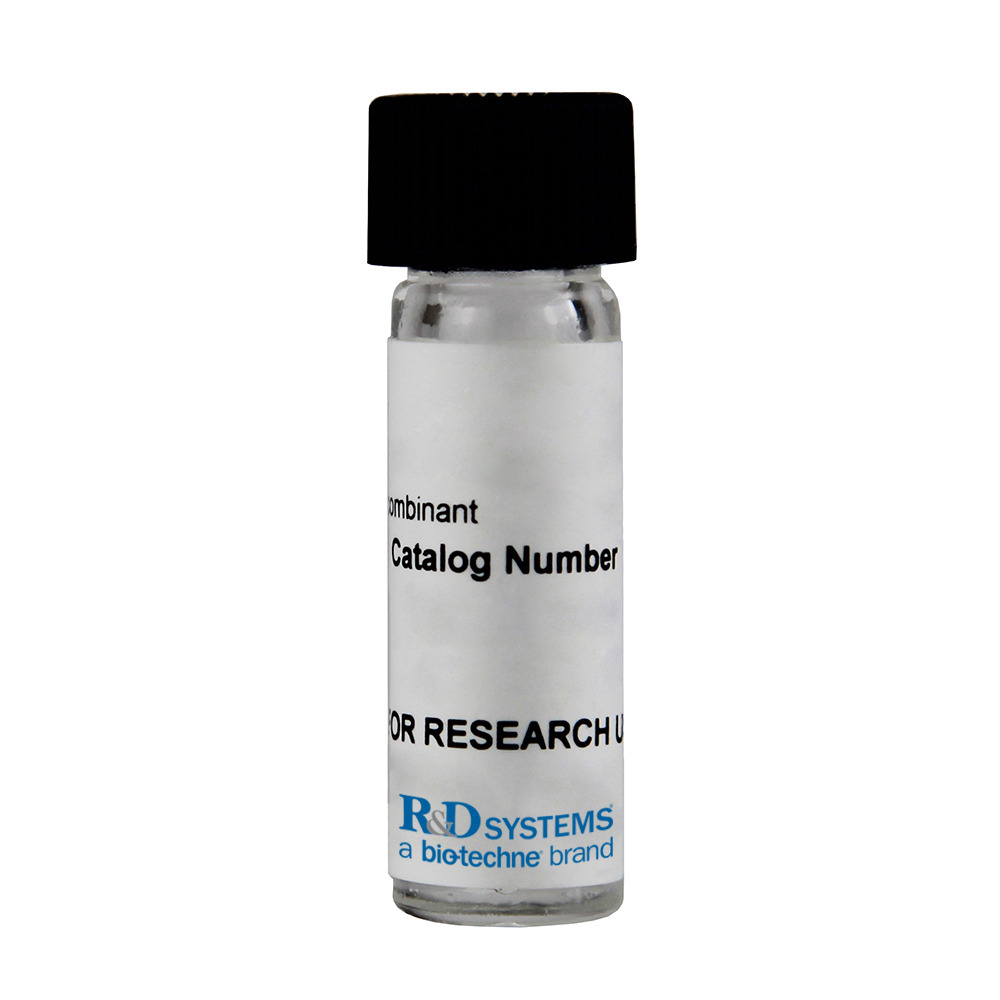Recombinant Rat EphB1 Fc Chimera Protein, CF Summary
- R&D Systems NS0-derived Recombinant Rat EphB1 Fc Chimera Protein (1596-B1)
- Quality control testing to verify active proteins with lot specific assays by in-house scientists
- All R&D Systems proteins are covered with a 100% guarantee
Product Specifications
Optimal dilutions should be determined by each laboratory for each application.
| Rat EphB1 (Met18-Gln538) Accession # P09759 |
IEGRMD | Human IgG1 (Pro100-Lys330) |
| N-terminus | C-terminus | |
Analysis
Product Datasheets
Carrier Free
CF stands for Carrier Free (CF). We typically add Bovine Serum Albumin (BSA) as a carrier protein to our recombinant proteins. Adding a carrier protein enhances protein stability, increases shelf-life, and allows the recombinant protein to be stored at a more dilute concentration. The carrier free version does not contain BSA.
In general, we advise purchasing the recombinant protein with BSA for use in cell or tissue culture, or as an ELISA standard. In contrast, the carrier free protein is recommended for applications, in which the presence of BSA could interfere.
1596-B1
| Formulation | Lyophilized from a 0.2 μm filtered solution in Tris. |
| Reconstitution | Reconstitute at 200 μg/mL in sterile PBS. |
| Shipping | The product is shipped at ambient temperature. Upon receipt, store it immediately at the temperature recommended below. |
| Stability & Storage: | Use a manual defrost freezer and avoid repeated freeze-thaw cycles.
|
Reconstitution Calculator
Background: EphB1
EphB1, also known as Elk, Cek6, Net, and Hek6 (1), is a member of the Eph receptor family which binds members of the ephrin ligand family. There are two classes of receptors, designated A and B. Both the A and B class receptors have an extracellular region consisting of a globular domain, a cysteine-rich domain, and two fibronectin type III domains. This is followed by the transmembrane region and the cytoplasmic region. The cytoplasmic region contains a juxtamembrane motif with two tyrosine residues, which are the major autophosphorylation sites, a kinase domain, and a conserved sterile alpha motif (SAM) in the carboxy tail which contains one conserved tyrosine residue. Activation of kinase activity occurs after ligand recognition and binding. EphB1 has been shown to bind ephrin-B2, ephrin-B1,
ephrin‑A3, ephrin-A1, ephrin-A4, and ephrin-B3 (2, 3). The extracellular domains of human and rat EphB1 share 99% amino acid identity. Only membrane-bound or
Fc‑clustered ligands are capable of activating the receptor in vitro. While soluble monomeric ligands bind the receptor, they do not induce receptor autophosphorylation and activation (2). In vivo, the ligands and receptors display reciprocal expression (3). It has been found that nearly all the receptors and ligands are expressed in developing and adult neural tissue (3). The ephrin/Eph families also appear to play a role in angiogenesis (3).
- Eph Nomenclature Committee [letter]. (1997) Cell 90:403.
- Flanagan, J.G. and P. Vanderhaeghen (1998) Annu. Rev. Neurosci. 21:309.
- Pasquale, E.B. (1997) Curr. Opin. Cell Biol. 9:608.
Citations for Recombinant Rat EphB1 Fc Chimera Protein, CF
R&D Systems personnel manually curate a database that contains references using R&D Systems products. The data collected includes not only links to publications in PubMed, but also provides information about sample types, species, and experimental conditions.
9
Citations: Showing 1 - 9
Filter your results:
Filter by:
-
EphB1 causes retinal damage through inflammatory pathways in the retina and retinal Müller cells
Authors: Liu, L;Jiang, Y;Al-Shabrawey, M;Ren, X;Wang, S;Steinle, JJ;
Molecular vision
Species: Rat
Sample Types: Whole Cells
Applications: Bioassay -
Targeting the Eph/Ephrin System as Anti-Inflammatory Strategy in IBD
Authors: A Grandi, I Zini, S Palese, C Giorgio, M Tognolini, F Marchesani, S Bruno, L Flammini, AM Cantoni, R Castelli, A Lodola, A Fusari, E Barocelli, S Bertoni
Front Pharmacol, 2019-06-17;10(0):691.
Species: Rat
Sample Types: Recombinant Protein
Applications: ELISA Capture -
A neuroprotective astrocyte state is induced by neuronal signal EphB1 but fails in ALS models
Authors: GE Tyzack, CE Hall, CR Sibley, T Cymes, S Forostyak, G Carlino, IF Meyer, G Schiavo, SC Zhang, GM Gibbons, J Newcombe, R Patani, A Lakatos
Nat Commun, 2017-10-27;8(1):1164.
Species: Mouse
Sample Types: Whole Cells
Applications: Bioassay -
Proteomic Analysis of a Rat Cerebral Ischemic Injury Model after Human Cerebral Endothelial Cell Transplantation
Authors: Hyung-Seok Kim
J Korean Neurosurg Soc, 2016-10-24;59(6):544-550.
Species: Human
Sample Types: Whole Cells
Applications: Bioassay -
EphB4 forward signalling regulates lymphatic valve development.
Authors: Zhang, Gu, Brady, John, Liang, Wei-Chin, Wu, Yan, Henkemeyer, Mark, Yan, Minhong
Nat Commun, 2015-04-13;6(0):6625.
Species: Human
Sample Types: Antibody
Applications: Enzyme Assay -
PI3K contributed to modulation of spinal nociceptive information related to ephrinBs/EphBs.
Authors: Yu L, Zhou X, Yu J, Huang H, Jiang L, Zhang F, Cao J, Yan M
PLoS ONE, 2012-08-03;7(8):e40930.
Species: Mouse
Sample Types: In Vivo
Applications: In Vivo -
EphrinB2 induces tyrosine phosphorylation of NR2B via Src-family kinases during inflammatory hyperalgesia.
Authors: Slack S, Battaglia A, Cibert-Goton V, Gavazzi I
Neuroscience, 2008-07-18;156(1):175-83.
Species: Rat
Sample Types: In Vivo
Applications: In Vivo -
Reverse endocytosis of transmembrane ephrin-B ligands via a clathrin-mediated pathway.
Authors: Parker M, Roberts R, Enriquez M, Zhao X, Takahashi T, Pat Cerretti D, Daniel T, Chen J
Biochem. Biophys. Res. Commun., 2004-10-08;323(1):17-23.
Species: Human
Sample Types: Whole Cells
Applications: Bioassay -
Antiangiogenic and antitumor efficacy of EphA2 receptor antagonist.
Authors: Dobrzanski P, Hunter K, Jones-Bolin S, Chang H, Robinson C, Pritchard S, Zhao H, Ruggeri B
Cancer Res., 2004-02-01;64(3):910-9.
Species: Rat
Sample Types: Whole Cells
Applications: Bioassay
FAQs
No product specific FAQs exist for this product, however you may
View all Proteins and Enzyme FAQsReviews for Recombinant Rat EphB1 Fc Chimera Protein, CF
There are currently no reviews for this product. Be the first to review Recombinant Rat EphB1 Fc Chimera Protein, CF and earn rewards!
Have you used Recombinant Rat EphB1 Fc Chimera Protein, CF?
Submit a review and receive an Amazon gift card.
$25/€18/£15/$25CAN/¥75 Yuan/¥2500 Yen for a review with an image
$10/€7/£6/$10 CAD/¥70 Yuan/¥1110 Yen for a review without an image

